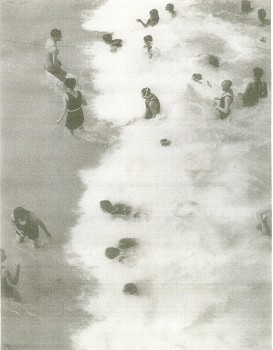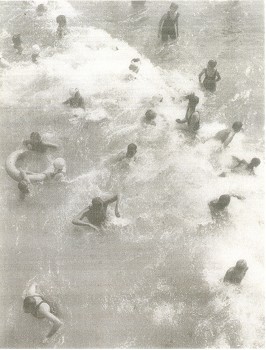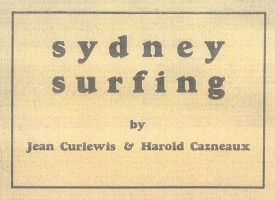
curlewis & carneaux : sydney, 1929
| home | catalogue | history | references | appendix |
 |
surfresearch.com.au
curlewis & carneaux : sydney, 1929 |
WE don't realise
it of course.
The phenomenon
of our surfing beaches.
We are not a
modest race and in most cases we are more apt to exaggerate, rather than
under-
estimate our
country's attractions.
But we don't
realise surfing.
We have grown
up with it and to us it seems quite natural.
But it staggers
tourists - yes, even Americans.
America, Holland,
Norway, Sweden and South Africa have all written to the Australian Surf
Life-Saving Association for handbooks of our methods as the first step
towards emulating us.
Our surfing beaches.
Our long coast
scalloped as neatly as a guest towel.
In each scallop,
a mile or so of beach sprinkled as thickly with multi-coloured bathers
as a a birthday cake with sugar hundreds-and-thousands.
Behind each beach,
a village like a vaudeville- a fantastic revue of merry-go-rounds, soda
fountains, picture shows, bandstands.
Piles of white
flats, airy as houses built of playing cards.
Behind the villages,
hills hollowed like amphitheatres.
Tier upon tier
of houses, all the way up, like boxes at an opera.
From each balcony,
pink and .yellow bathing suits and blue and red towels hung out to dry
like flags.
In the steep
garden husbands and wives garden domestically in their bathing suits.
Butcher boys
dash on their rounds with towels round their necks.
Babies come home
from kinder-garten, flick their diminutive bathers from the clothes line,
and nonchalantly depart again for a surf, quite on their own.
Business men
come home from the office and go for a dip before dinner as inevitably
as men in other cities wash their hands.
In the kitchenettes,
saucepans cook unattended on the gas rings.
For in a surfing
city recipes always read "Simmer forty minutes while you have your surf."
Page 2
That is on a week-day.
On Sundays three
surfs are considered reasonable.
The first lasts
from waking until breakfast, the second from breakfast until lunch, the
third from lunch until dinner.
Of course, if
it is really hot and you do not mind sharks you can go in again from dinner
until midnight.
At Clovelly one
recent heatwave night a rank of cars one mile long drew up along the beach.
At Bondi, bathing
suits and full evening dresses walked together along the lighted promenade.
People came from the theatres at half-time and finished the evening in
the water.
Mothers put their
babies to sleep on the sand-entire families camped out all night.
Twenty-seven
short years ago surfing did not exist.
Bathing on open
beaches was forbidden.
It was considered
improper.
.Not until 1902
were the restrictions lifted.
We shall not
state on which beach was shot the first shoot.
That is a question
which still shakes councils and surf clubs to their foundations.
Other games are
confined to the young and strong.
Here on the beach
an elderly lady placidly parks her spectacles with her towel and wades
happily into the fray.
A father takes
a baby a few months old from its mother and holds it so that the foam brushes
its bare feet.
The baby goes
on sucking its comforter quite unperturbed.
But the actual
surfing is only half of it.
One does not
go for just a dip.
One goes for
"a dip and a bake."
To visitors from
overseas the sunbaking is just as surprising as the bathing.
They come to
the beach wall and lean over-and their first impression is of a battlefield.
For acres the
beach is covered with smooth brown bodies that seem sun-slain.
Some are flung
face downwards-others lie face up, eyes closed, the sun beating on their
faces.
All are immobile
as marble.
They do not stir
and sigh as sleepers do--no sleeper was ever so passionately abandoned
to sleep as these bodies are to the sun.
An English visitor
once stared down at the tranced figures.
He was a thin
highly intelligent University man and he peered through his pince-nez for
some time very curiously.
Then he turned
suddenly: "What," he asked, "are they all thinking about ?"
Page 3
What are they
all thinking about?
What do they
see in the gold- brown mesmeric dusk behind their closed lids while the
heat soaks out of the sand into every pore of their skins?
That Englishman
has been ten years in Australia by now.
Does he still
wonder what they think about?
Did he spend
too many years at his University learning how to think, for him ever to
master the trick of how to fling himself on the hot sand, stop his mind
like a clock, and not think at all?
What is it doing
to the race, physically and mentally, these hours, days, years, of mixing
with sea and sun?
For an answer
to the physical question, one has only to glance at the ranks of the surf
clubs.
The tourist or
journalist who could write a description of them without employing the
phrase "young Greek gods" or "statues of bronze,'- has not yet been born.
It simply cannot
be done.
For the surf
is a sculptor.
Those tons of
breakers fall like mallet blows and swimmers are chiselled slim and straight.
The foam, fizzing
and stinging like iced champagne, restores to slack fibres the priceless
quality that doctors call "tone."
The sun polishes
the skin to an incredible smoothness.
Until the Australian
surfer 100ksiihe,-,.-I cannot belpit,-,.-ayoung Greek god.
The extraordinary
glow of well-being after a surf!
A philosopher
once laid down the maxim that one should never commit suicide until one
had had a good dinner.
He should have
said "Until one had had a good surf."
What is it doing
on the mental side?
That question
is not so easv to answer.
The rest of the
world seems to feel it as a personal injury that Australians do not spend
less time on their beaches and more in their offices and factories getting
rich.
Getting rich.
Australians know
exactly what they would do if, by dint of cutting out a surf and working
one hour longer every day, they became rich.
They would knock
off working one hour earlier, put on a well-worn bathing suit and go for
a surf. Why toil to get rich to do exactly the same thing that you are
doing now, not-rich?
Why get all hot
and bothered over More Production when the thing you want is produced by
the Pacific cost free? .
It is a philosophy
that drives the American efficiency-expert into a mental home.
Page 4
Yet this apparently lotus-eating sport has produced one of the most highly trained and organised voluntary bodies of the world -a phenomenon of social service.
Strike just one
note on the bell that hangs on a frame on the beach.
In one instant
the tranced figures are electrified into life.
Perhaps fifty
of them are racing at full speed towards the reel of the life-line.
They make a living
wall to keep the crowd back.
In the cleared
space five men are moving like high-speed machinery.
One has slipped
on a belt and is racing down the beach, three are paying out the line through
hands raised over their heads.
One is. checking
the run of the reel.
A man or a woman
has been carried out by the current.
The task of bringing
them back to the beach alive takes more than a lotus-eater.
It is a grim
choking struggle that calls for every ounce of wind, nerve and whip-cord
in the body of a highly trained man.
And it may even
cost that man his life.
Yet any of the
fifty men who sprang up at the ~tro~e of the bell are competent and ready
to take their place in the belt.
For the first half-dozen years of surfing there was no attempt of any kind to make the new sports; l;fe.rb~n th~growi.ng number of accidents mad~ a few young men decide to shoulder the task themselves-=-not for any kind of payment, simply as their form of service to society.
As there were
no surf clubs anywhere else in the world they had to invent their own methods,
drill and gear.
They studied,
they experimented, they practised, they subscribed for equipment, they
got doctors to teach them the art of resuscitation.
To-day there are
sixty-nine surf clubs in N .S. W. with a membership of five thousand.
Membership is
possible only after a gruelling test.
These men patrol
all the beaches up and down the coast from dawn to dusk in the week-ends.
They provide
out of their own pockets (of late years they have been assisted to some
extent by the councils) for the reels, surf boats, bells, shark towers,
and first-aid kits, used in their work, and in some cases, when the council
cannot afford it, pay a professional life-saver to guard the beach on week-days.
The associated
clubs have been in existence twenty-one years.
They have saved
thirteen thousand lives!
Page 5
The general public
rather quaintly takes their services for granted.
There is an interesting
passage in the yearly report of one of the clubs.
It states (hot
complainingly but by way of explanation to members as to why they will
have to work harder than ever in organising the financial side) :
"During this season
members of this club made 24 rescues with belt and line, 42 persons were
given assistance to reach safety, and eleven cases were given treatment
as a result of accidents, (dumpers etc.).
The club did
not receive one penny piece or even a letter of thanks for services rendered".
In short, members are expected to pay for the privilege of risking their lives.
Until a few years
ago, a surf beach was a sober sight.
Black or navy
was the universal wear, and people actually obeyed the regulation which
said, "A bathing suit shall cover the body from the neck to the knee".
Those draggled
knee length bathing suits, those big straw hats, tied under the chin with
black tape!
And then a daring
shop opened a shipment of coloured suits.
No one has called
Australia an artistic country.
But no one can
deny that nowadays it has a nice- a very nice- taste in bathing suits.
I cannot imagine
that anywhere in the world is there such a bursting bomb, a flower bed,
a living carpet, a ballet, a kaleidoscope of colour as there is this year
at Coogee or Bondi (for some reason the other beaches do not flame quite
so bright).
Not only bathing
suits- giant umbrellas, deck chairs, towels, caps, cloaks, shoes, even
the utilitarian rubber bags for wet bathers, are the creation of an artist
on a gigantic, magnificent spree.
Deauville is
supposed to do these things rather well, but it does in hundreds what our
beaches do in hundreds of thousands.
Even the famous
and much-advertised beach at Waikiki is an anti-climax to Australians in
the matter of colours and numbers.
Now the designers
are making brilliant rubber butterflies and blossoms for girybathers to
wear poised on their shoulders, and caps, and wrists.
"Flowers in the
ocean", say the conservatives.
"How incongruous!
"
Page 6
But it is always the incongruous that gives the kick to the cocktail.
The sand.
We call it white.
But have you
ever picked up a handful and noticed how many grains are bright purple
and bright orange?
Every now and
then an English visitor wrote home, "... someone is eaten, but the sport
goes on."
Shark tragedies
are few, but horrible.
Too horrible
to dwell upon.
Yet each tragedy
has had as a relief an almost incredible act of bravery on the part of
a member or members of the crowd.
Experts are divided
on the question of how best to cope with the menace, and the most widely
differing schemes have been proposed.
To net in an
enclosure, to patrol the breakers with aeroplanes, to sink a ship across
the entrance to the bay, to engage native experts to kill them with knives
(some native sailors from one of the ships did actually swim out on one
occassion and were greatly disappointed because sharks were short that
day), to bomb them from small launches, to harpoon them, to trawl for them.
England's patron
saint rescued a maiden from a dragon.
Australia's patron
saint will certainly be the man who finally rescues her national sport
from a shark.
With perhaps
a minor, but still honoured, niche for the man who exterminates the bluebottle.
Photograph a.
 |
The end of the shoot. The three figures in the foreground have been successful in catching the breaker out at sea and coming in with it to the shore. Photographed at Coogee. |
 |
Swirwling waters that foam like brisk wine catch the bathers on the very edge of the ocean. Stirring them in a maelstrom of bubbles. Buffeting their bodies. Loosening their limbs. Awaking their livers. (sic) And tossing them light-hearted and laughing on the yellow sand. |
 |
Sydney Surfing. Arthur McQuitty, McQuitty House, Regent Street, Sydney, for Art in Australia Ltd., 24 Bond Street, Sydney. 1929, unpaginated. Image left: Partial cover. |

| home | catalogue | history | references | appendix |